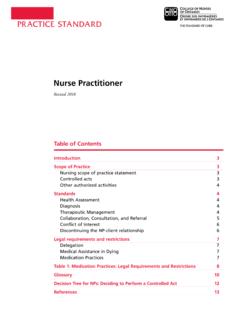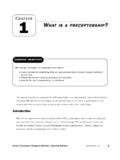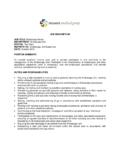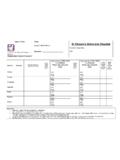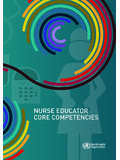Transcription of A-Voiding Catastrophe: Implementing a Nurse …
1 Instructions for Continuing Nursing Education Contact Hours appear on page 21. A-Voiding Catastrophe: Implementing a Nurse - driven Protocol Candace Mori ccording to the Institute of A Medicine (IOM, 1999), health care environments in the United States are fragmented and less The effectiveness of a Nurse - driven protocol for indwelling urinary catheter removal is described, including a review of the gap analy- sis, protocol implementation, and outcomes. safe than they should be. Preventable medical errors cost billions of dollars. They also account for more deaths than motor vehicle accidents, AIDS, Purpose or breast cancer, contributing to an To evaluate the effectiveness of a Nurse - driven indwelling urinary catheter estimated 44,000-98,000 deaths per removal protocol in an acute care setting.
2 Year. The IOM also suggested a hos- pital is a hazardous place due to the Background increased risk for nosocomial infec- tions, incorrect procedures or other The most common hospital-acquired infection is catheter-associated urinary untoward events, administration of tract infection (CAUTI). These infections account for 40% of all hospital-acquired incorrect medications, adverse reac- infections. Although indwelling urinary catheters may be a needed intervention, tions, and processes of care that studies have demonstrated over half of the patients who receive a urinary impede recovery. Such processes catheter do not have a valid indication for its use. include giving nothing by mouth for tests, creating excess noise that con- Methodology tributes to lack of sleep, initiating A retrospective chart review allowed measurement of prevalence of catheter bed rest orders that inhibit mobility, usage, dwell time, and CAUTIs before and after implementation of the protocol.
3 And using therapeutic devices inap- Indwelling catheter usage was tabulated monthly from nursing clinical docu- propriately. Additionally noted was mentation. The sum of catheter days was divided by the total patient days and the increased likelihood for an older multiplied by 100 to get a percentage of catheter usage for each month. Dwell adult patient to experience these time was calculated by tabulating the length of time in days each patient had hospital hazards. an indwelling catheter and dividing it by the total number of catheterized The IOM (2001) also reported care patients to determine the mean duration in days. The number of CAUTIs was being delivered in hospitals did not divided by the total number of patients with urinary catheters and multiplied by reflect best evidence.
4 The gap 100 to get the percentage of CAUTI. between current evidence and actual practice was estimated to be 17 years Results in some instances. Of the 10 quality Prior to Implementing the Nurse - driven removal protocol, indwelling urinary recommendations in this report, one catheter usage was , mean dwell time was days, and the CAUTI rate of the most pertinent was utilizing was After implementation of the protocol, catheter usage was , evidence-based decision making. mean dwell time was days, and the CAUTI rate The best available scientific evidence should be the foundation of all Implications for Nursing patient care and should not vary from clinician to clinician. Findings support the use of a Nurse - driven protocol to reduce the incidence and The Centers for Medicare & duration of urinary catheterization, to decrease incidence of CAUTI, and to Medicaid Services (CMS, 2013) sup- improve the quality of care for hospitalized patients.
5 Ported these recommendations by linking health care reimbursements to quality improvement in patient care. CMS initiated pay for perform- Candace Mori, MSN, RN, ACNS-BC, ONC, is Clinical Nurse Specialist, Medical/Surgical Unit, ance initiatives by decreasing rev- Wooster Community Hospital, Wooster, OH. January-February 2014 Vol. 23/No. 1 15. enue for failure to follow quality of used in the search included catheter- ence of pressure ulcers, the likeli- care processes ( , aspirin for acute associated urinary tract infection hood of having a catheter doubles. myocardial infarction), falls, pressure (CAUTI), indwelling urinary catheter, Chen and colleagues (2013) re- ulcers, and nosocomial infections health care-associated infections, infec- ported the use of a reminder proto- such as catheter-associated urinary tion prevention, and urinary tract infec- col to remove urinary catheters can tract infection.
6 The significant tion (UTI). diminish the practice of urinary awareness of urinary tract infection According to Gray (2010), CAUTI catheterization and reduce the inci- (UTIs) associated with catheteriza- is diagnosed when a patient with a dence of CAUTI. In a randomized tion is growing due to staggering urinary catheter develops two or controlled trial conducted on two prevalence and infection rates. more signs and symptoms of a UTI, respiratory intensive care units, 278. Gotelli and colleagues (2008) report- such as fever, flank pain, change in patients with a urinary catheter in ed 16%-25% of hospitalized persons urine characteristics, or hematuria. place for more than 2 days were receive an indwelling urinary cathe- The presence of a catheter in the uri- assigned to an intervention group ter.
7 Stokowski (2009) further noted nary tract disturbs the body's ability (use of the reminder to remove the UTI accounts for 40% of all health to eliminate unwanted bacteria from catheter) or the control group (no care-associated infections. According the lower urinary tract. A urinary reminder). Authors found use of a to The Institute for Healthcare catheter in the bladder can cause reminder protocol decreased utiliza- Improvement (IHI, 2011), 80% of bacteria colonization at a rate of 3%- tion rates of indwelling urinary hospital-acquired UTI are due to 10% per day, and increase to 100% catheters by 22%, reduced median indwelling urinary catheters; hospi- colonization within a 30-day dwell duration of catheterization, and tals and nursing homes combined time. Pathogens can enter the uri- decreased the incidence of CAUTI by have more than 1 million cases of nary tract during catheter insertion, 48%.
8 Catheter-associated UTI (CAUTI) through the catheter lumen, or by Using a retrospective chart review annually. manipulation of the catheter of 187 patients (99 pre-intervention, The prevalence of CAUTI in the drainage bag. Furthermore, the uri- 88 post-intervention) from a com- hospital is linked to the frequent use nary catheter can increase the inci- munity hospital, Voss (2009) found a of indwelling urinary catheters. dence of infection by providing a geriatric protocol to make clinicians Prevalence rates for indwelling uri- surface for bacteria to adhere, caus- aware of the appropriate use of nary catheters in hospitals are 25%- ing inflammation and trauma to the catheters and the parameters for 35%; in the intensive care units, urinary epithelium. catheter removal to be effective in rates are much higher at 67%-76% Five million catheters are placed reducing the incidence of indwelling (Gray, 2010).
9 CAUTI can raise hospi- annually in the United States, but urinary catheters. Use of the proto- tal costs, prolong patients' length of 50% of patients do not meet appro- col reduced the mean duration of stay, and complicate the recovery of priate indications. Additionally, 40% catheterization by and critically ill patients (Stokowski, of physicians are unaware their reduced device days from 136 to 44. 2009). With the foundation provid- patients have indwelling urinary Furthermore, device utilization ratio ed by the work of the IOM (1999) catheters (IHI, 2011). For those who decreased from to 10%. and the CMS (2013), as well as liter- have indwelling urinary catheters, Elpern and co-authors (2009) con- ature examining CAUTI rates, Nurse - the daily risk of developing a CAUTI cluded a Nurse - driven intervention driven protocols have been devel- is 3%-7% (Palmer, Lee, Dutta-Linn, to avoid unwarranted urinary oped to decrease the incidence of Wroe, & Hartmann, 2013).
10 Mortality catheter use may result in reduction indwelling catheter usage and pre- and length of stay are increased sig- in duration of catheterization and vent catheter-associated urinary tract nificantly in patients with CAUTI occurrence of CAUTI. In this study, infection. (Chant, Smith, Marshall, & Friderich, which was conducted in a medical 2011). These extra days, along with intensive care unit, days of use of a the cost of antibiotic therapy, could urinary catheter and rates of CAUTI. Literature Review add $980-$2,900 to a patient's hospi- were compared before and after the A literature review was completed talization. In a year, CAUTI can add implementation of a Nurse - driven of English-language research pub- 90,000 hospital days and $424-$451 protocol. During the 6-month inter- lished in 2000-2010 on indwelling million to the cost of health care in vention period, 337 patients had urinary catheter usage and CAUTI.
